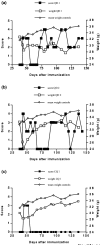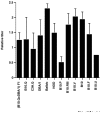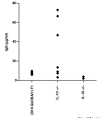Critical role of the major histocompatibility complex and IL-10 in matrilin-1-induced relapsing polychondritis in mice
- PMID: 15380048
- PMCID: PMC546288
- DOI: 10.1186/ar1218
Critical role of the major histocompatibility complex and IL-10 in matrilin-1-induced relapsing polychondritis in mice
Abstract
Relapsing polychondritis (RP) is an autoimmune disease that affects extra-articular cartilage. Matrilin-1-induced relapsing polychondritis (MIRP) is a model for RP and is useful for studies of the pathogenic mechanisms in this disease. There are indications that the major histocompatibility complex (MHC) class II plays a major role in RP, since DR4+ patients are more commonly affected than controls. We have now addressed the role of the MHC region, as well as the non-MHC contribution, using congenic mouse strains. Of the MHC congenic strains, B10.Q (H2q) was the most susceptible, the B10.P (H2p) and B10.R (H2r) strains developed mild disease, while B10 strains carrying the v, b, f, or u H2 haplotypes were resistant. A slight variation of susceptibility of H2q strains (B10.Q> C3H.Q> DBA/1) was observed and the (B10.Q x DBA/1)F1 was the most susceptible of all strains. Furthermore, macrophages and CD4+ T cells were the most prominent cell types in inflammatory infiltrates of the tracheal cartilage. Macrophages are the major source of many cytokines, such as interleukin-10 (IL-10), which is currently being tested as a therapeutic agent in several autoimmune diseases. We therefore investigated B10.Q mice devoid of IL-10 through gene deletion and found that they developed a significantly more severe disease, with an earlier onset, than their heterozygous littermates. In conclusion, MHC genes, as well as non-MHC genes, are important for MIRP induction, and IL-10 plays a major suppressive role in cartilage inflammation of the respiratory tract.
Figures




Similar articles
-
A new animal model for relapsing polychondritis, induced by cartilage matrix protein (matrilin-1).J Clin Invest. 1999 Sep;104(5):589-98. doi: 10.1172/JCI5740. J Clin Invest. 1999. PMID: 10487773 Free PMC article.
-
Cartilage oligomeric matrix protein induction of chronic arthritis in mice.Arthritis Rheum. 2008 Jul;58(7):2000-11. doi: 10.1002/art.23554. Arthritis Rheum. 2008. PMID: 18576344
-
Relapsing polychondritis, induced in mice with matrilin 1, is an antibody- and complement-dependent disease.Am J Pathol. 2004 Mar;164(3):959-66. doi: 10.1016/S0002-9440(10)63183-5. Am J Pathol. 2004. PMID: 14982849 Free PMC article.
-
Collagen-induced arthritis in mice: a major role for tumor necrosis factor-alpha.Methods Mol Biol. 2007;361:265-84. doi: 10.1385/1-59745-208-4:265. Methods Mol Biol. 2007. PMID: 17172717 Review.
-
Cartilage-specific autoimmunity in animal models and clinical aspects in patients - focus on relapsing polychondritis.Arthritis Res. 2002;4(5):296-301. doi: 10.1186/ar425. Epub 2002 Jul 17. Arthritis Res. 2002. PMID: 12223103 Free PMC article. Review.
Cited by
-
Respiratory subtype of relapsing polychondritis frequently presents as difficult asthma: a descriptive study of respiratory involvement in relapsing polychondritis with 13 patients from a single UK centre.ERJ Open Res. 2021 Feb 15;7(1):00170-2020. doi: 10.1183/23120541.00170-2020. eCollection 2021 Jan. ERJ Open Res. 2021. PMID: 33614776 Free PMC article.
-
A nationwide study of the epidemiology of relapsing polychondritis.Clin Epidemiol. 2016 Jun 23;8:211-30. doi: 10.2147/CLEP.S91439. eCollection 2016. Clin Epidemiol. 2016. PMID: 27418855 Free PMC article.
-
Relapsing Polychondritis with Tracheobronchial Involvement: A Detailed Description of Two Pediatric Cases and Review of the Literature.Klin Padiatr. 2024 Feb;236(2):97-105. doi: 10.1055/a-2230-1521. Epub 2024 Jan 15. Klin Padiatr. 2024. PMID: 38224687 Free PMC article. Review.
References
-
- McAdam LP, O'Hanlan MA, Bluestone R, Pearson CM. Relapsing polychondritis: prospective study of 23 patients and a review of the literature. Medicine (Baltimore) 1976;55:193–215. - PubMed
-
- O'Hanlan M, McAdam LP, Bluestone R, Pearson CM. The arthropathy of relapsing polychrondritis. Arthritis Rheum. 1976;19:191–194. - PubMed
-
- Chang-Miller A, Okamura M, Torres VE, Michet CJ, Wagoner RD, Donadio JV, Jr, Offord KP, Holley KE. Renal involvement in relapsing polychondritis. Medicine (Baltimore) 1987;66:202–217. - PubMed
-
- Stastny P. Association of the B-cell alloantigen DRw4 with rheumatoid arthritis. N Engl J Med. 1978;298:869–871. - PubMed
-
- Lang B, Rothenfusser A, Lanchbury JS, Rauh G, Breedveld FC, Urlacher A, Albert ED, Peter HH, Melchers I. Susceptibility to relapsing polychondritis is associated with HLA-DR4. Arthritis Rheum. 1993;36:660–664. - PubMed
MeSH terms
Substances
LinkOut - more resources
Full Text Sources
Research Materials

